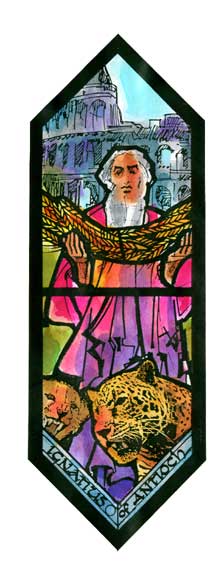|
|
|||

|
|||
Ignatius of Antioch Window The news about Jesus continued to spread quickly, even after the death of the apostles. By the middle of the second century, in spite of persecution, Christians could be found throughout most of the Roman Empire. During this period, leadership of the Church passed into Gentile hands, and much that is familiar to us today began to take shape. Already a form of the Apostles’ Creed was being used as a statement of faith, and the liturgy consisted of two parts: the reading and the communion, which was begun with a kiss of peace. Ignatius was one of the first generation of leaders after the apostles. As a young man he became a Christian through the ministry of the apostle John, and eventually followed in the apostolic succession as Bishop of Antioch. When Ignatius was about 80 years old, he was arrested for confessing to be a follower of “Christ God,” and was taken to Rome to be thrown to the beasts in the arena. But as he went, the journey became a triumphant procession. Christians cheered him on his way, and Church leaders came to visit. In response, Ignatius wrote seven letters. In them he addressed Church issues such as the three-fold order of ministry (bishops, priests, deacons) and the role of bishops in preserving the apostles’ teachings; and he emphasized core doctrines such as the dual (human-divine) nature of Jesus Christ and his central role in the ultimate consummation of history. But he also wrote intimately of his own impending martyrdom, of his longing to enter God’s presence, and of the “living water” which whispered within him, “Come to the Father.” Ignatius is one of many who could have been chosen to represent those who were “slain by a fierce wild beast.” Our window shows a 21st century view of Rome, where his martyrdom took place. The leopards represent the animals used to kill prisoners, and also the soldiers escorting Ignatius to Rome, whom he referred to as leopards because of their vicious treatment of him. The sheaf of wheat hints at the bread of the Eucharist (Christ’s presence in this window), as well as Ignatius’ statement, “I am God’s wheat and I am ground by the teeth of wild beasts that I may be found pure bread of Christ.”
Like Stars Appearing: The Story of the Stained Glass
Windows of St. George's Episcopal Church, Dayton, Ohio | |||
|
|||
